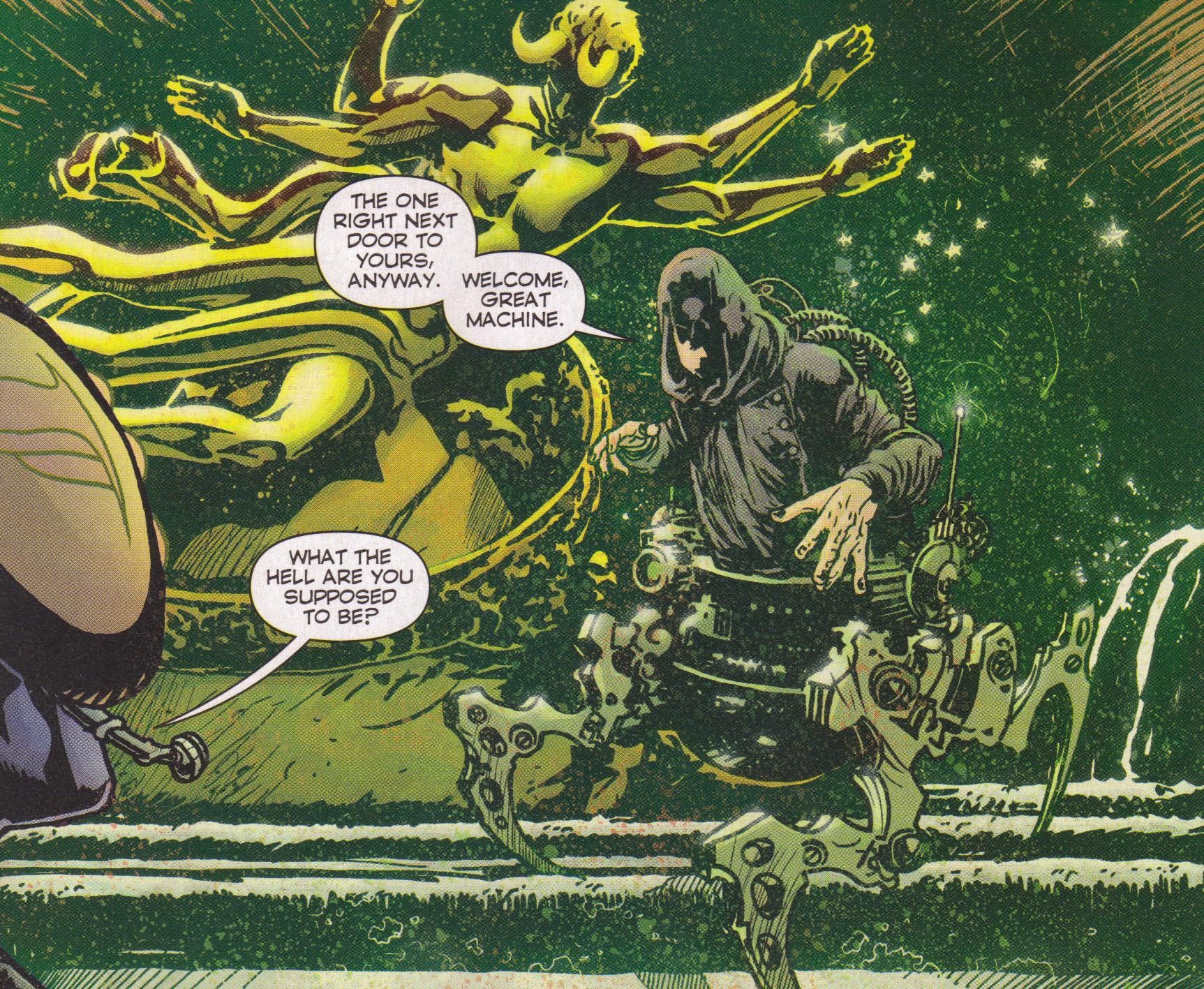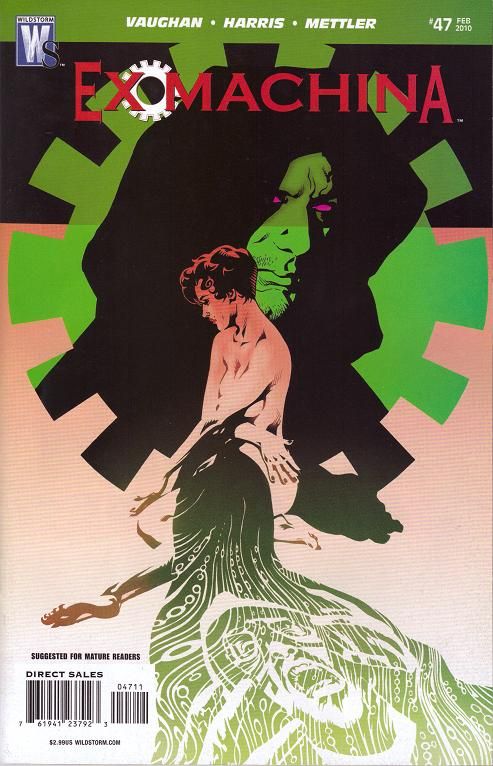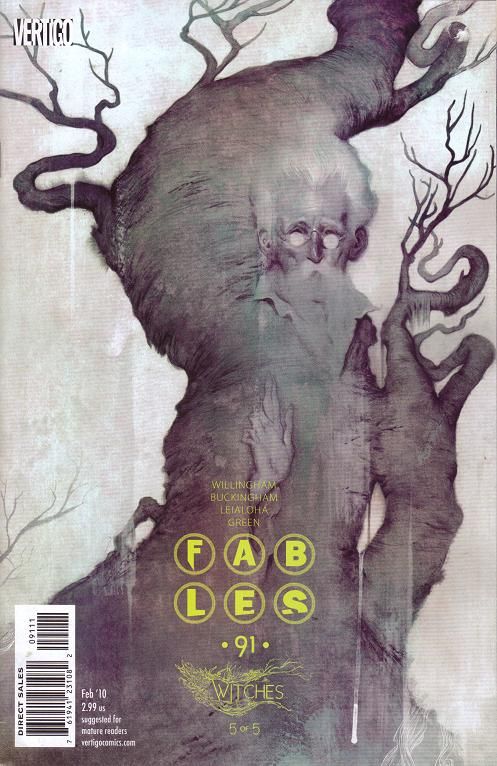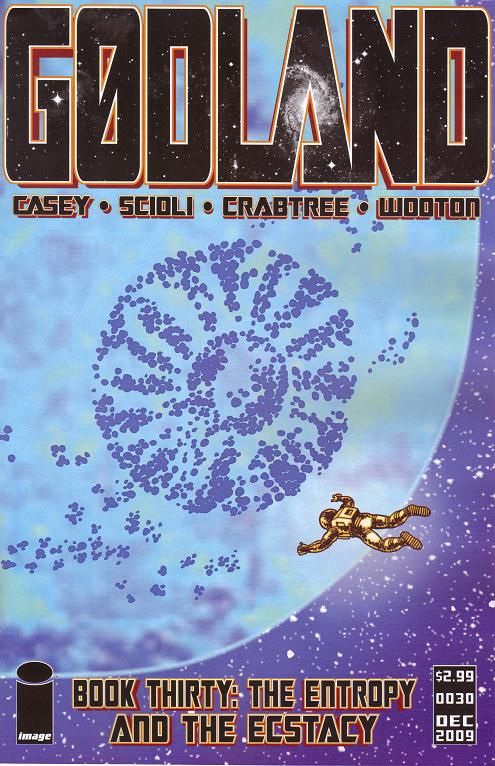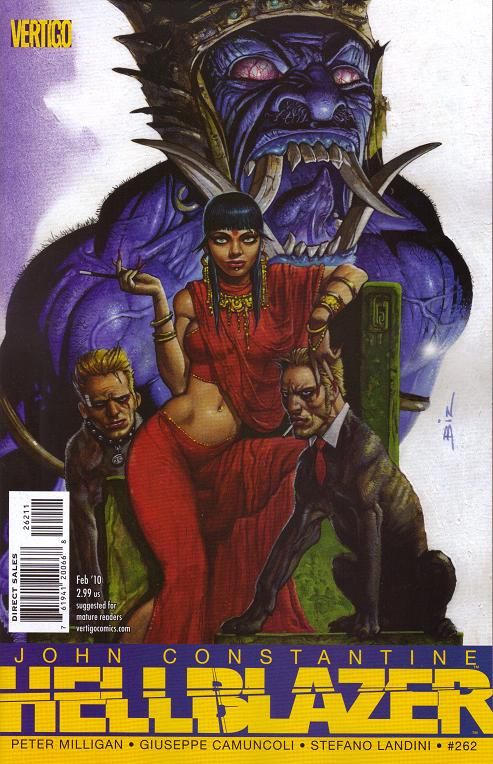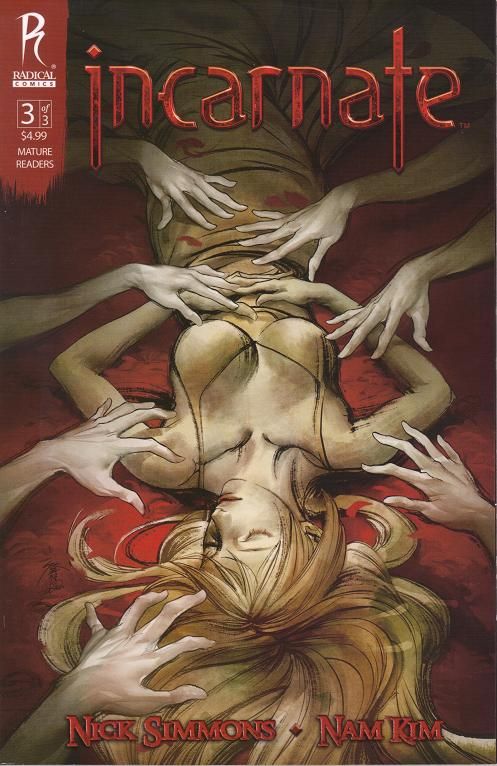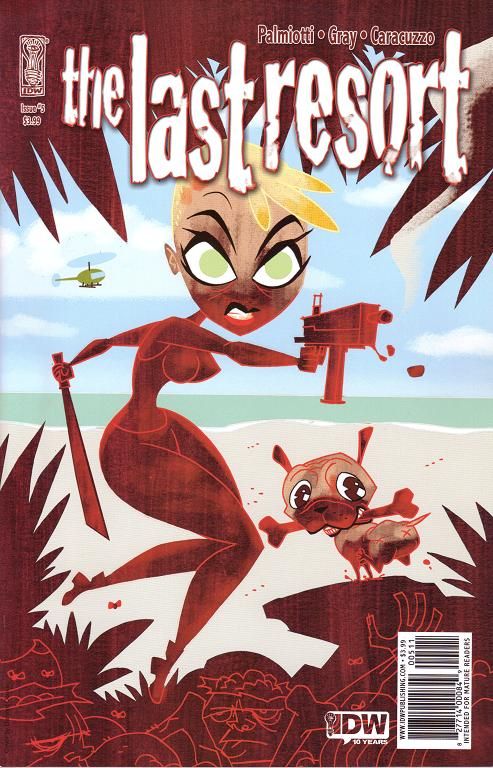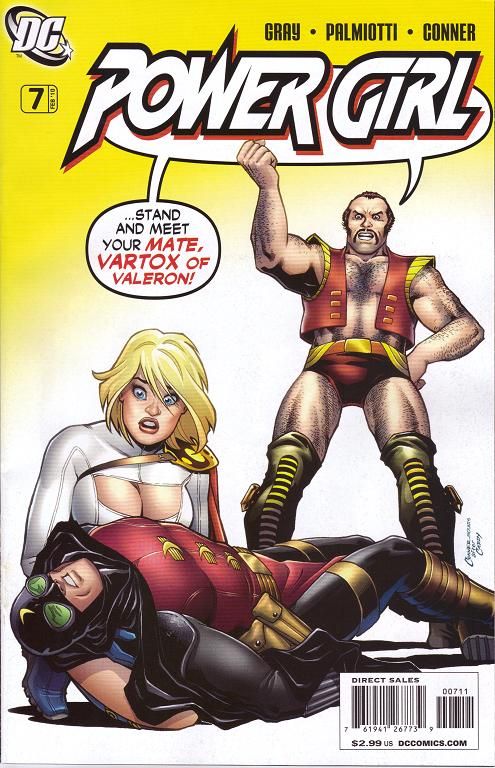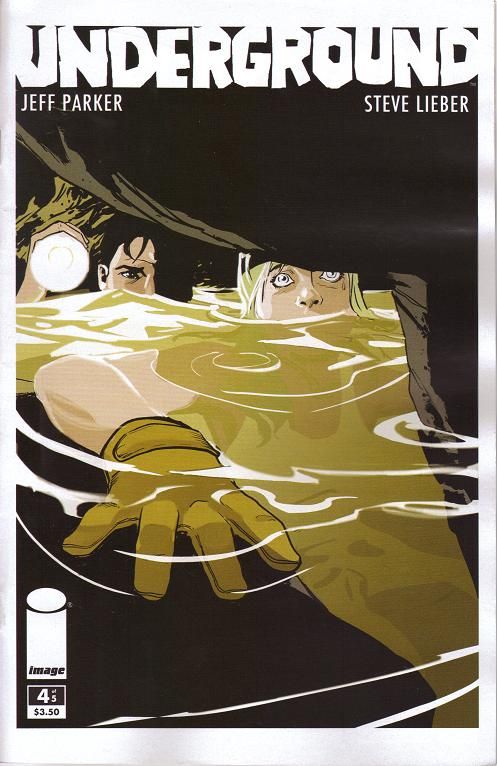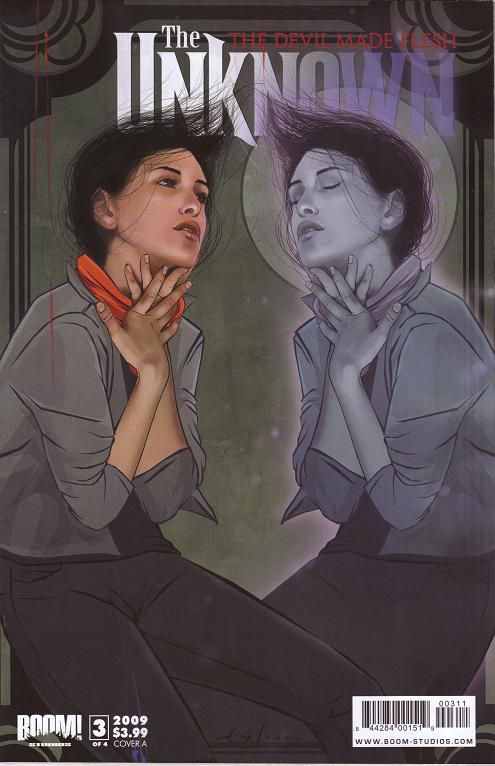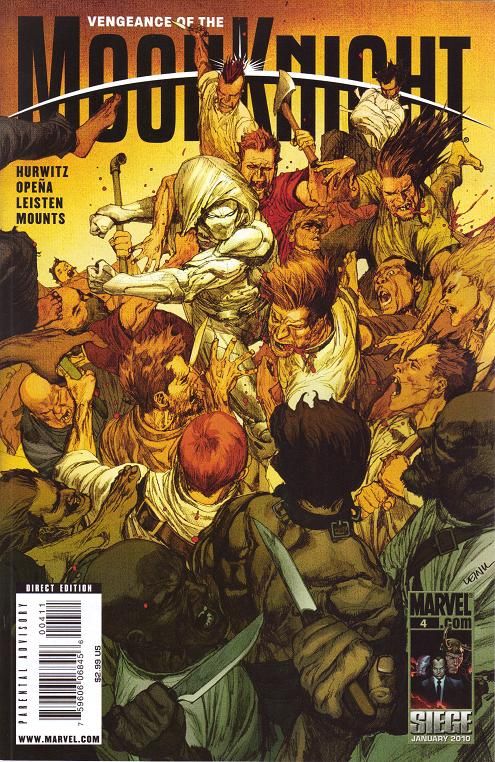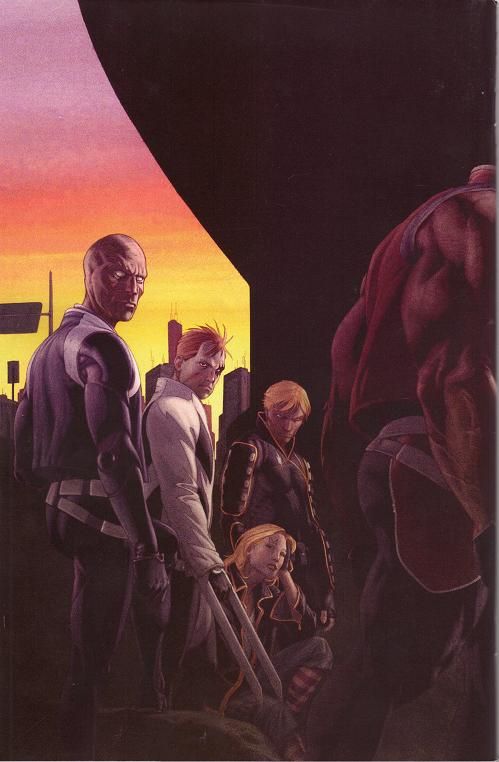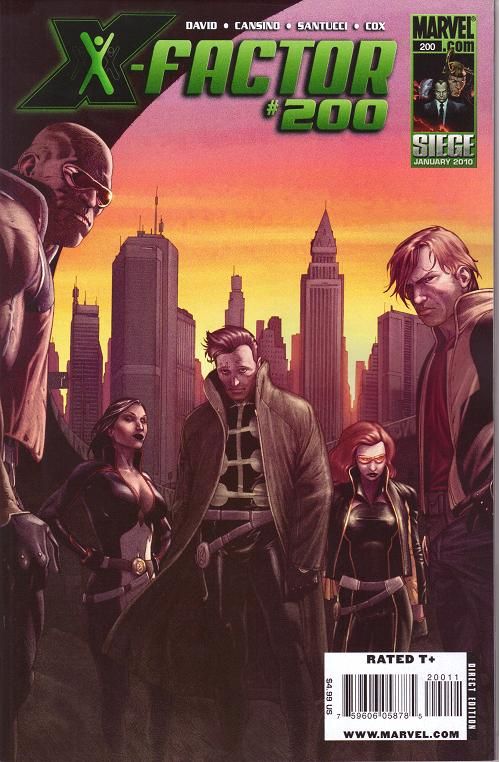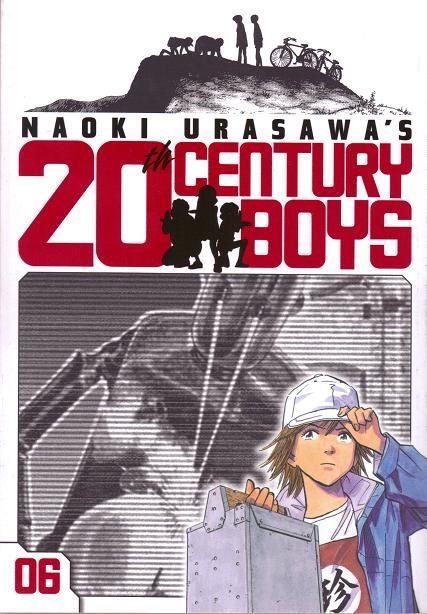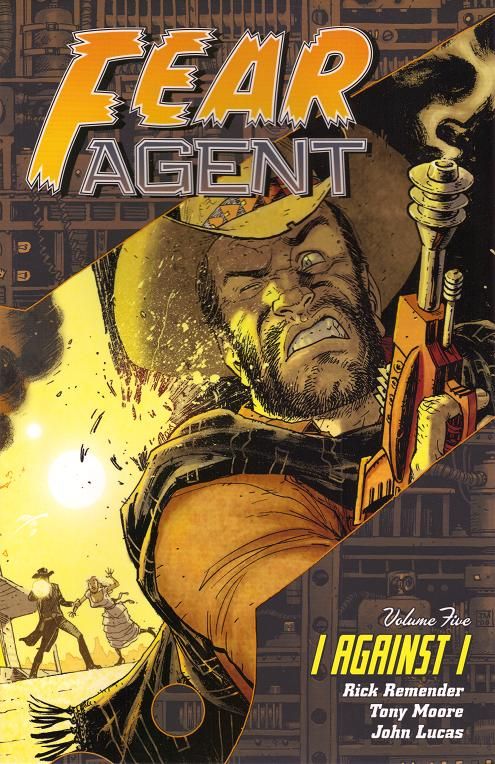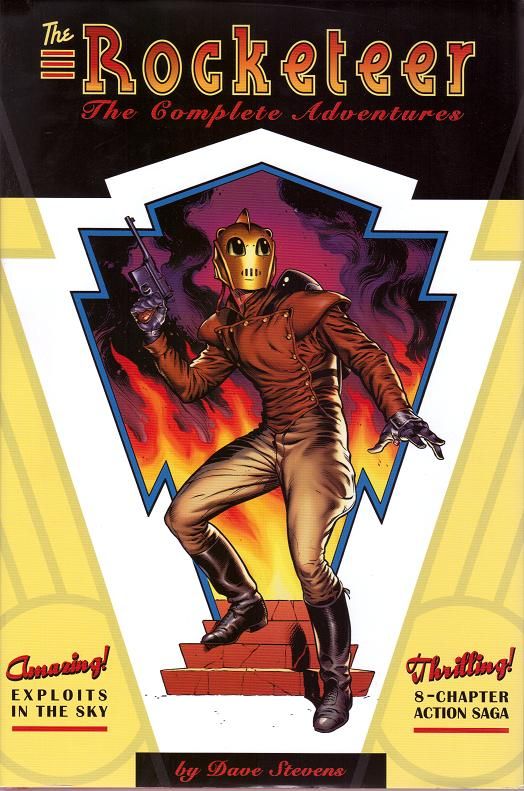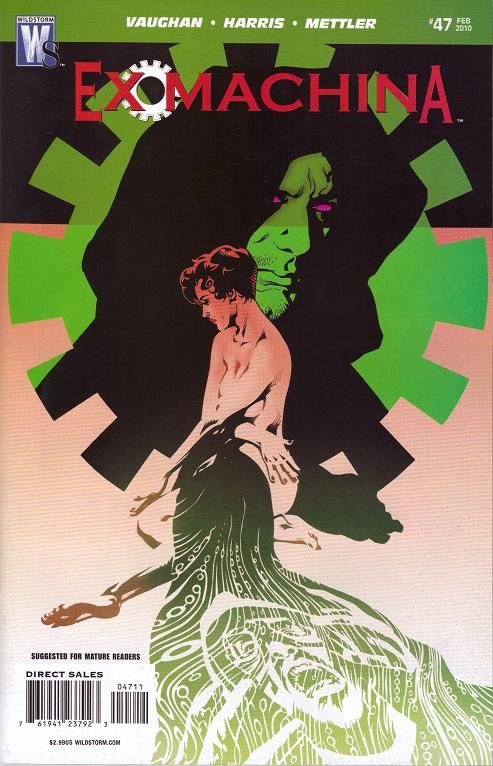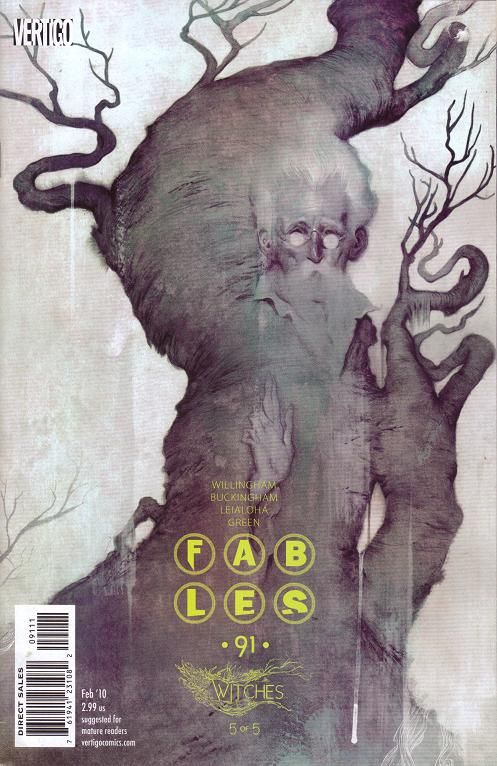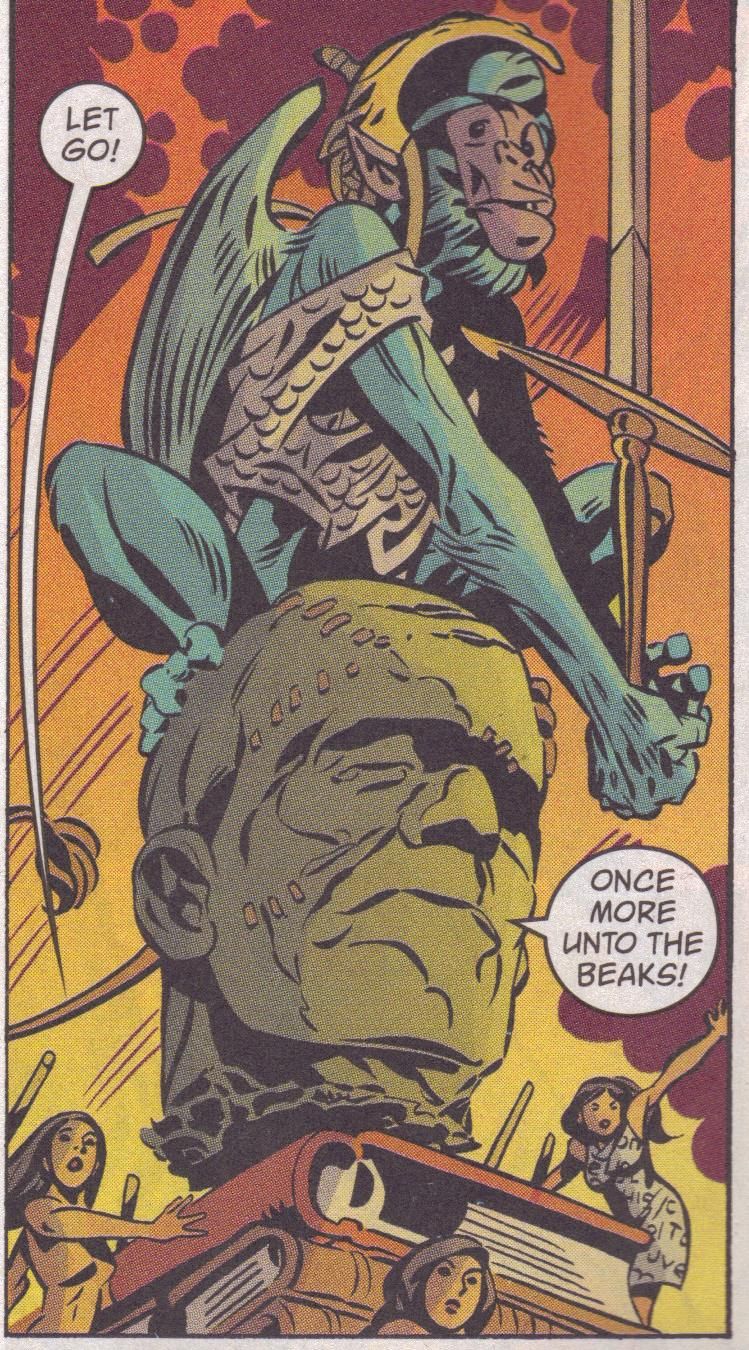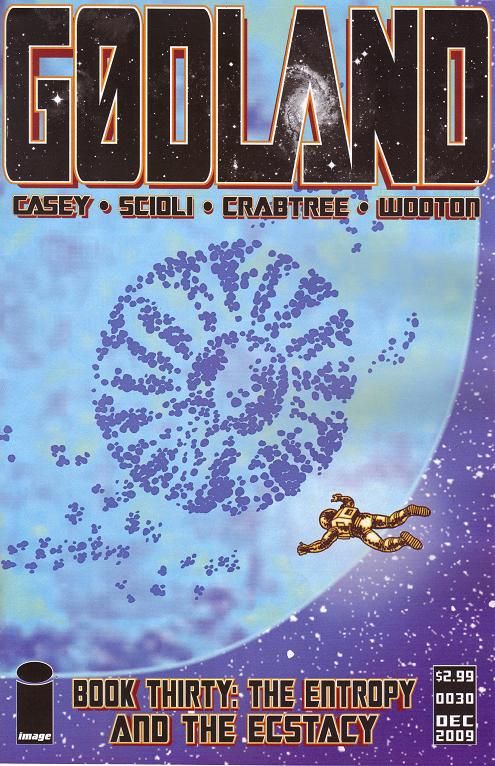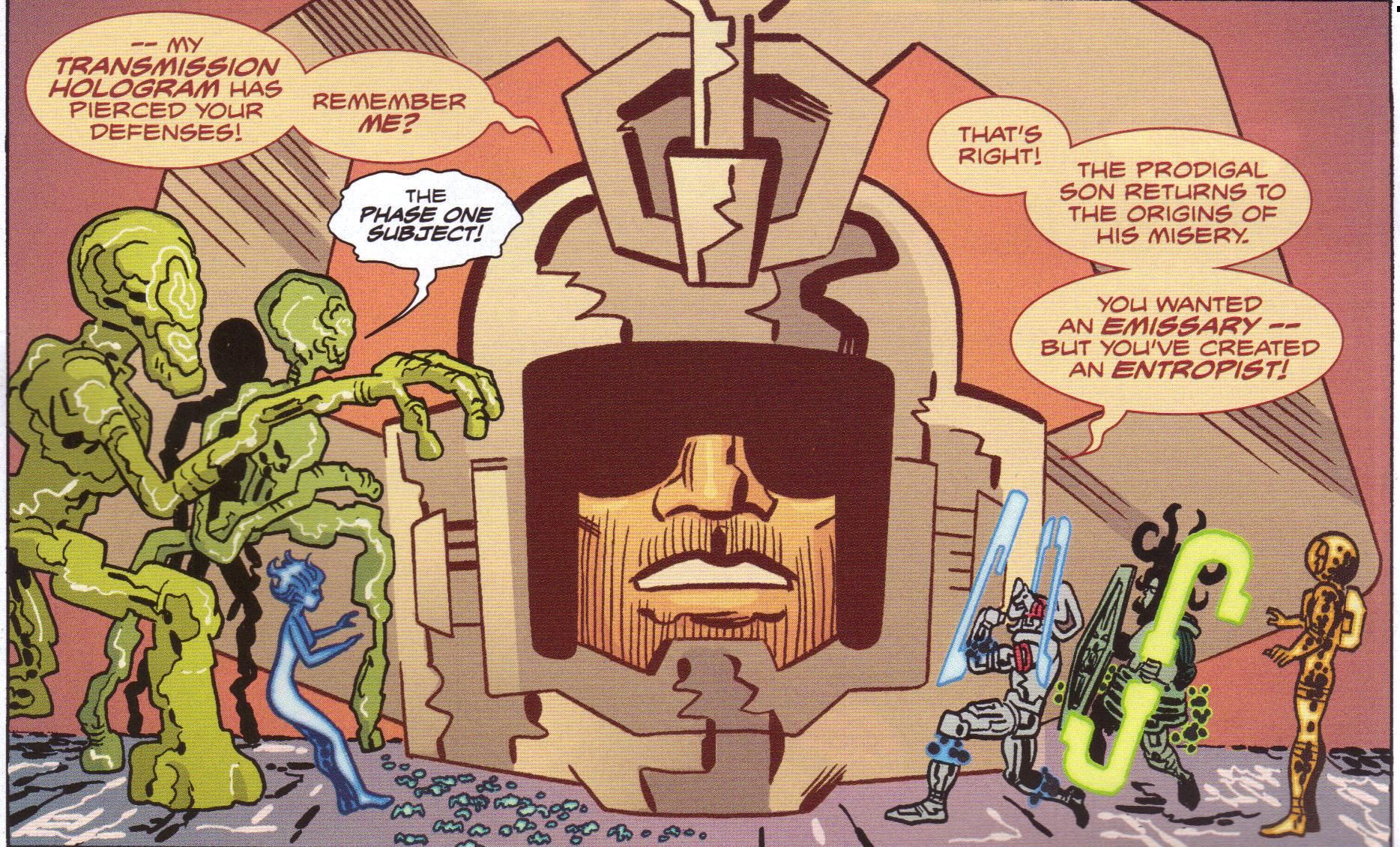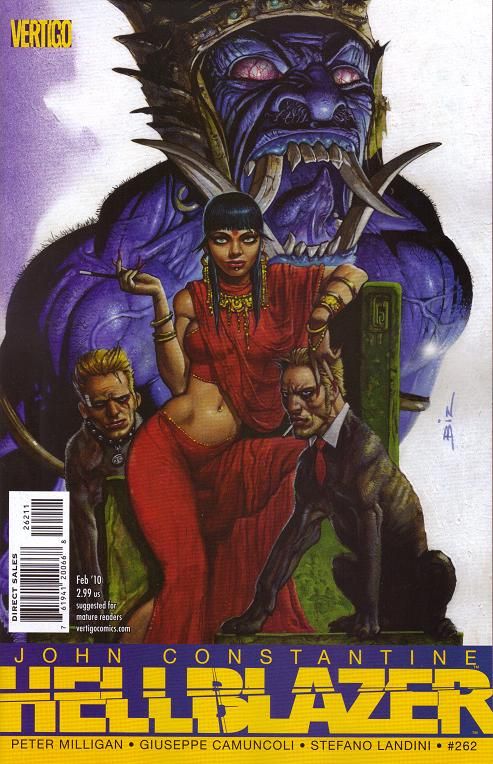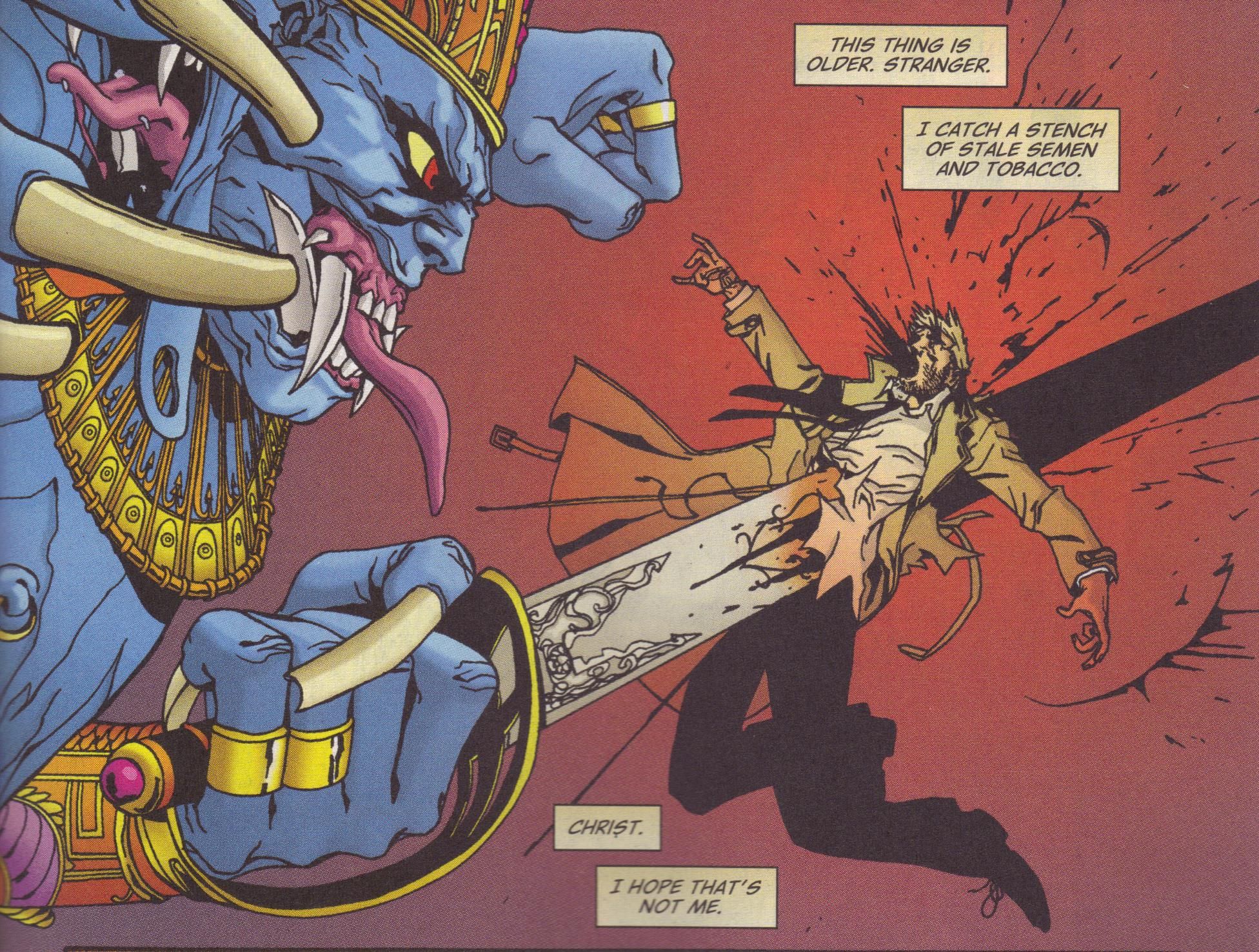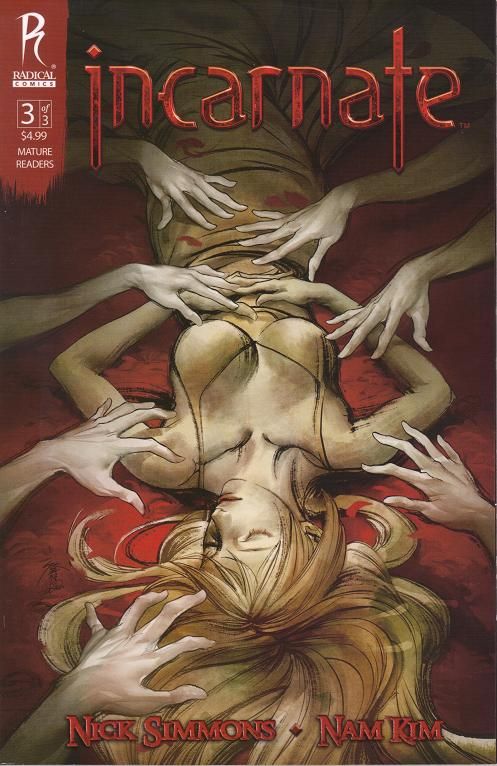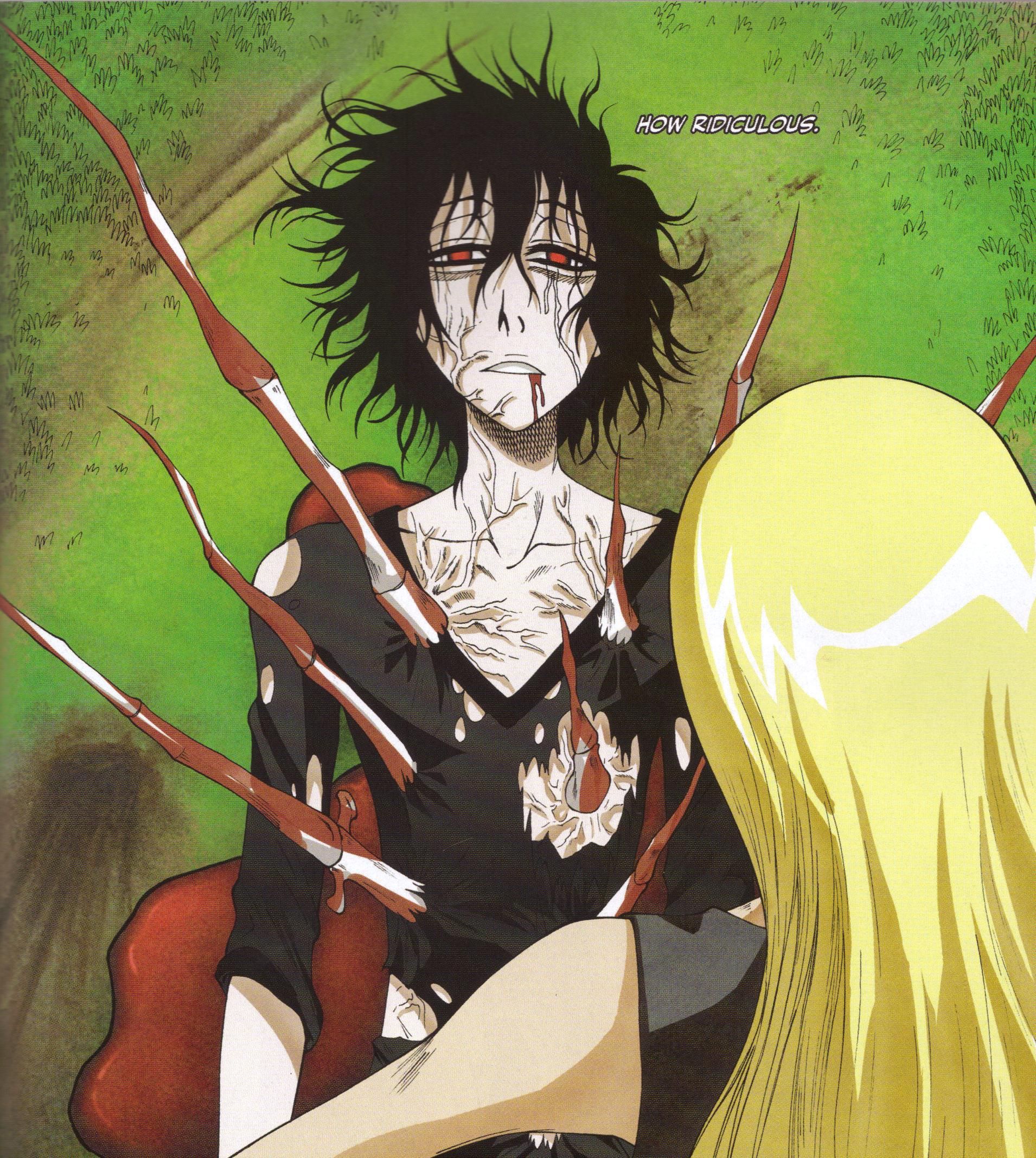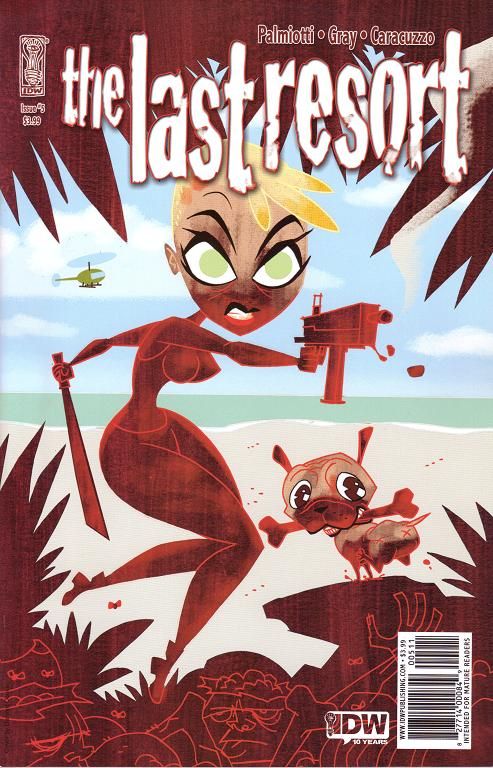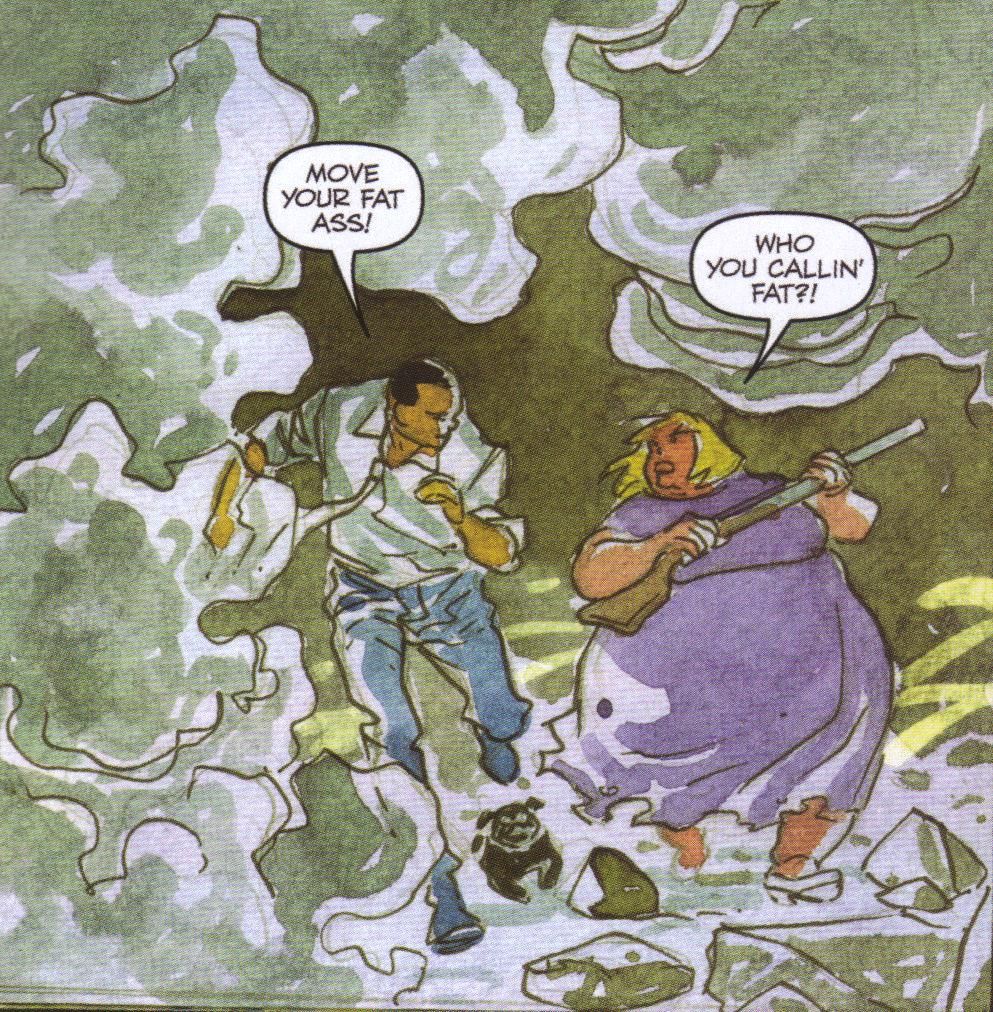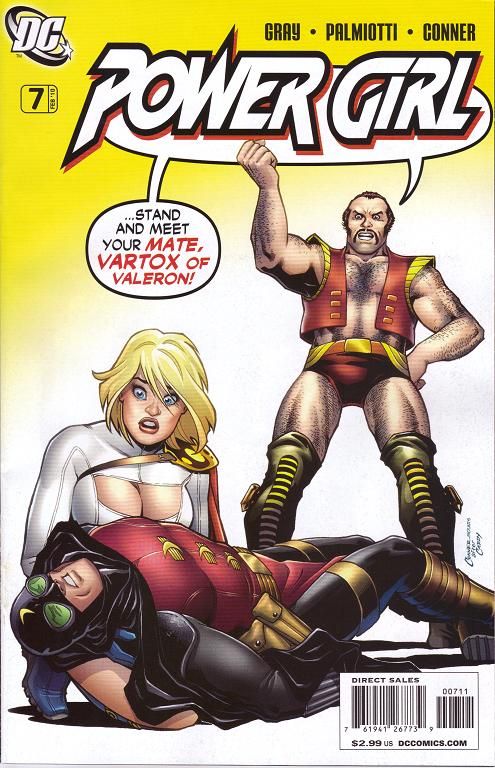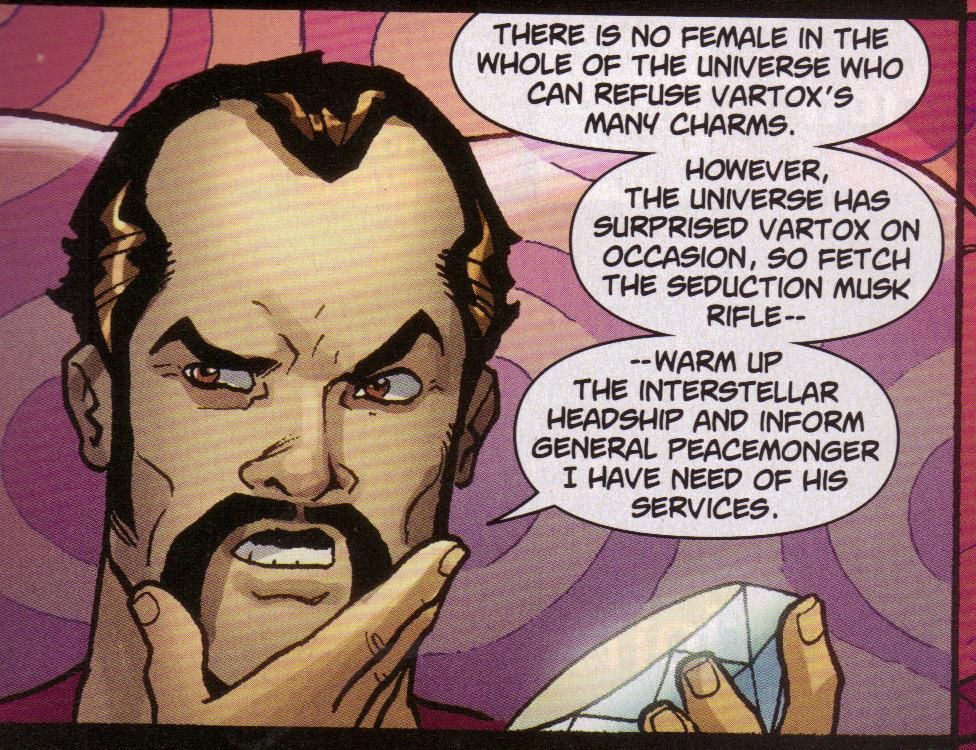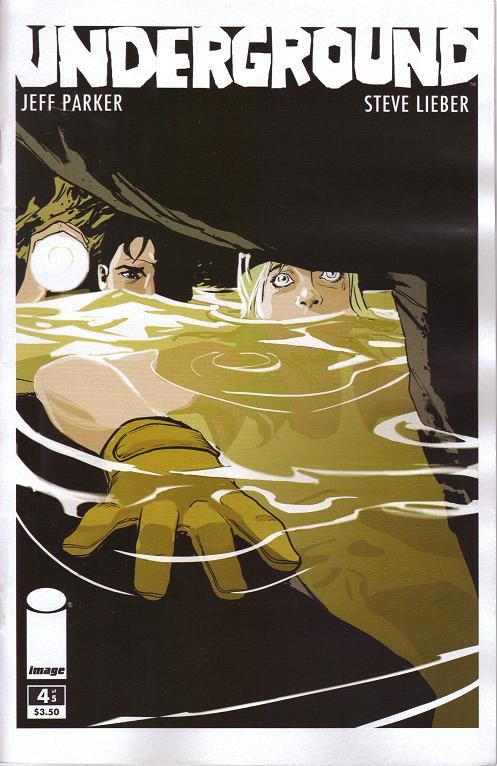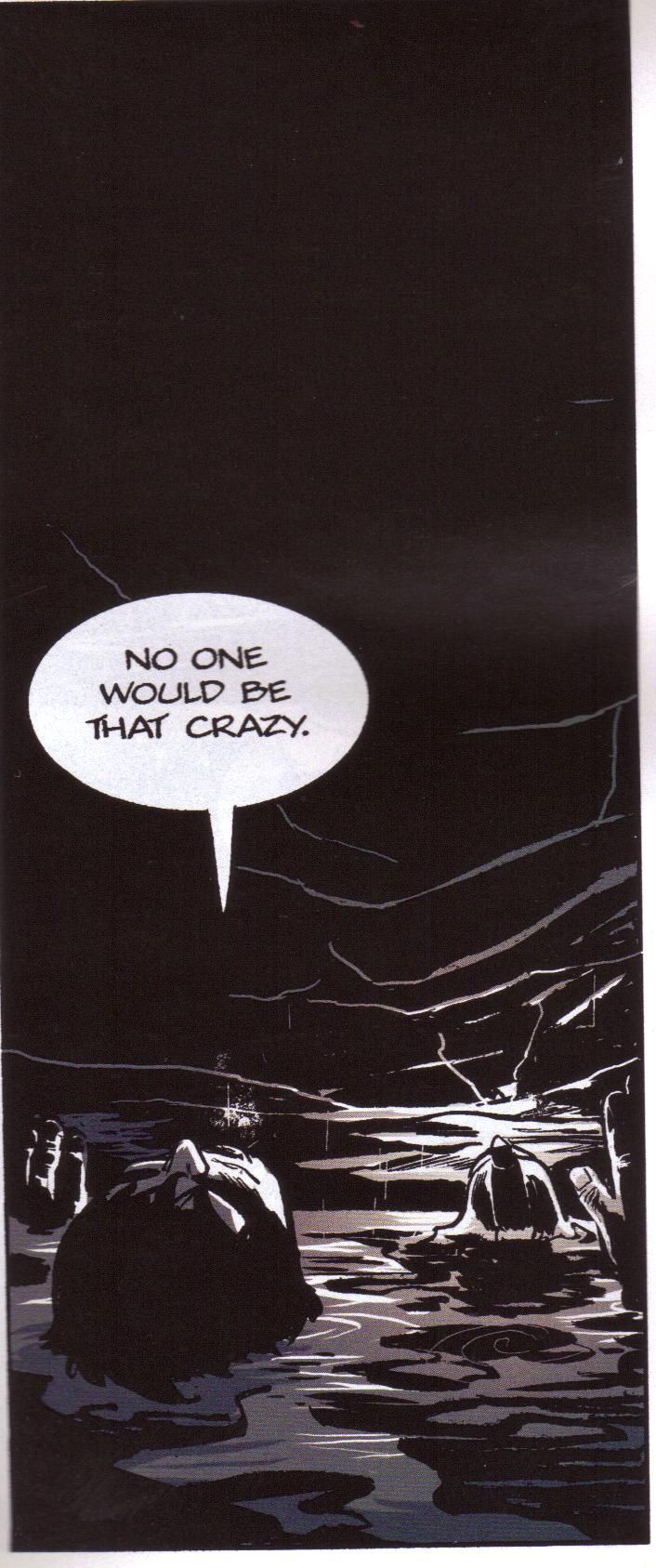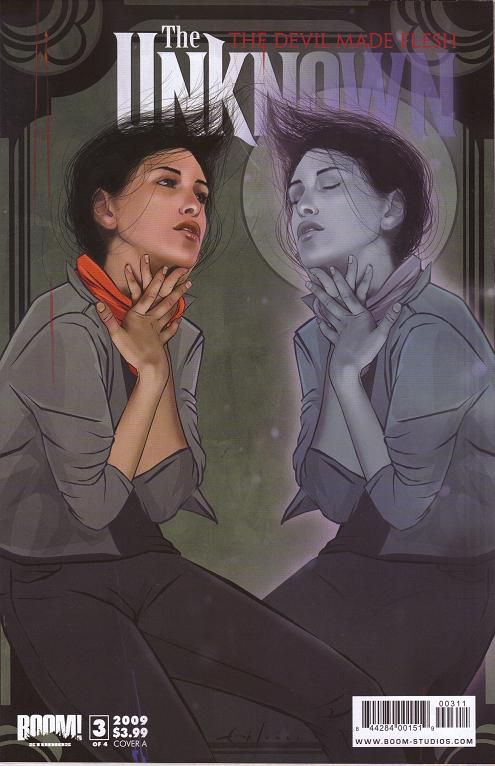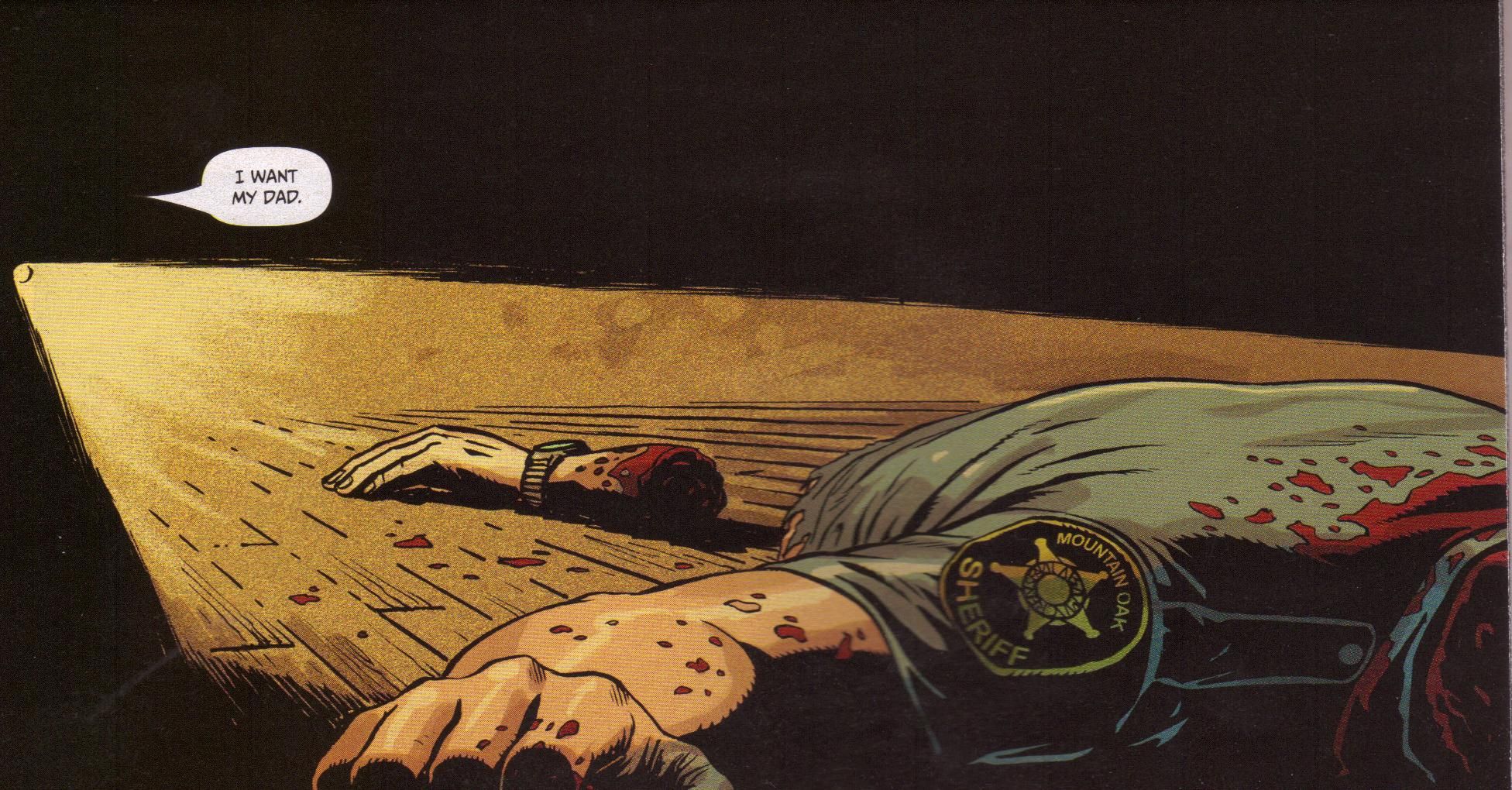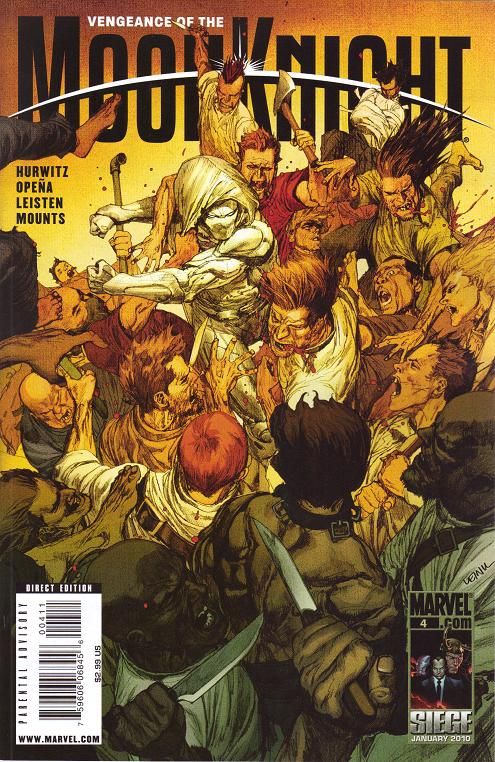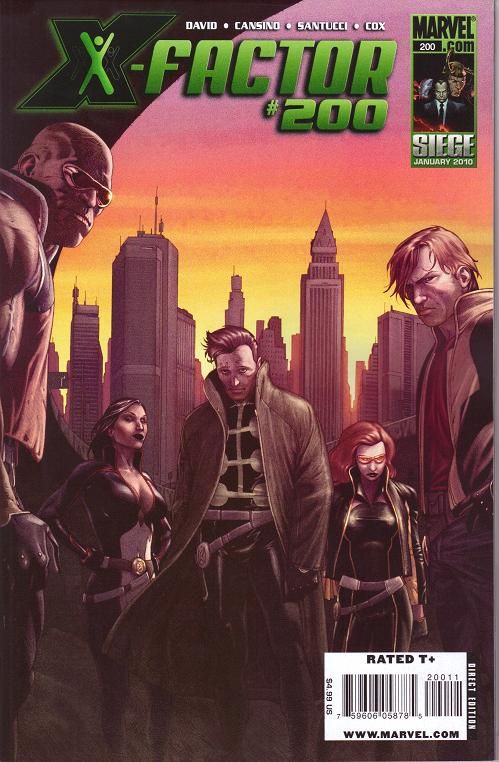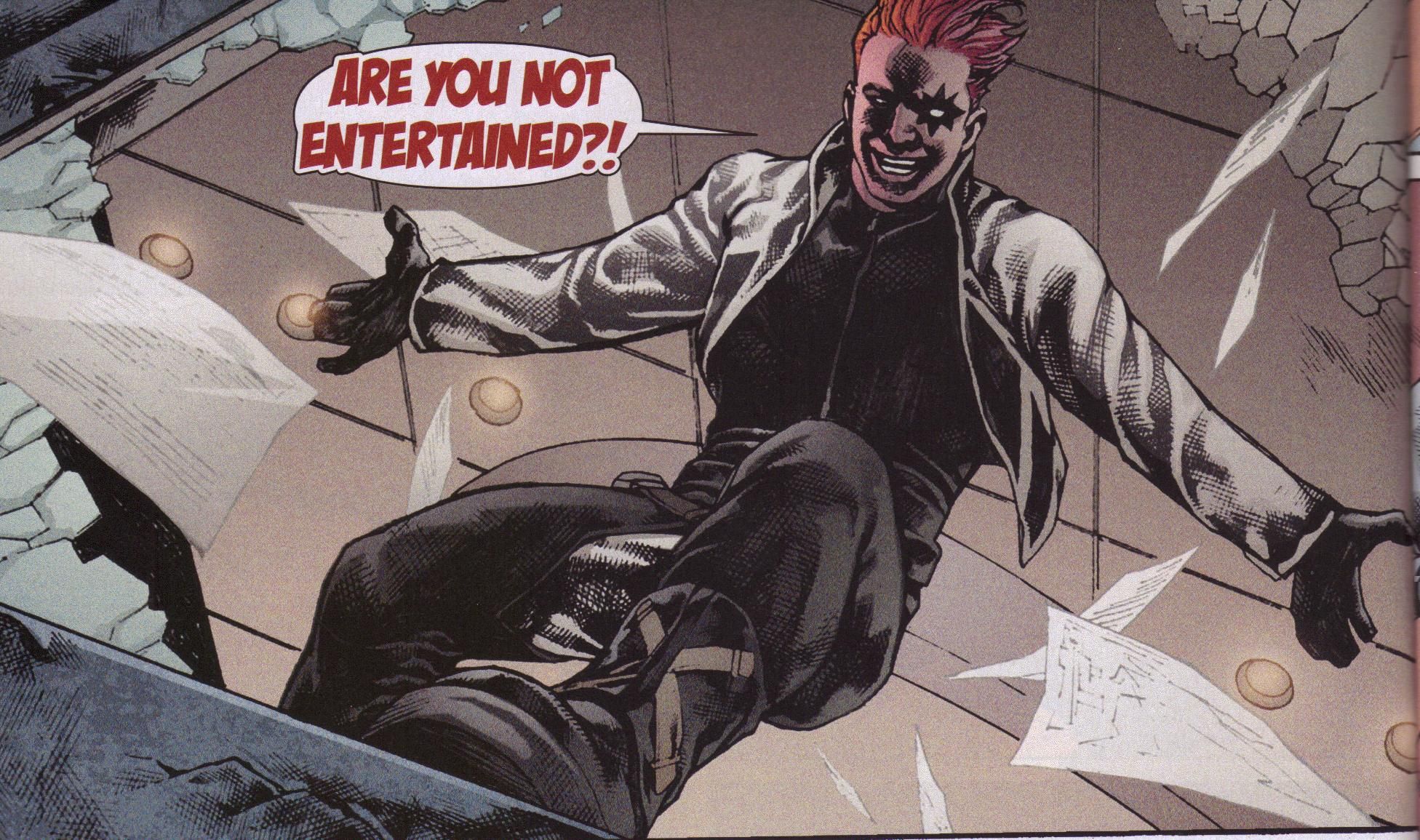Now hang our bloody colours by Damascus,
Reflexing hues of blood upon their heads,
While they walk quivering on their city walls,
Half-dead for fear before they feel my wrath.
Then let us freely banquet, and carous
Full bowls of wine unto the god of war,
That means to fill your helmets full of gold,
And make Damascus' spoils as rich to you
As was to Jason Colchos' golden fleece.
And now, Bajazeth, hast thou any stomach?
For those who weren't here last week, I'd like to point out that I'm only reviewing the single issues shown above, and not the three on the bottom row. I figured I'd put those up for two reasons: 1) To show you things you may have missed and were interested in; 2) To head off the questions like "Didn't you buy the new Rocketeer hardcover?" which I get every so often. Yes, I did buy it - I'm just not ready to write about it yet! 'Salright? Salright.
Ex Machina #47 ("Pro-Life Part Three") by Brian K. Vaughan (writer), Tony Harris (artist), JD Mettler (colorist), and Jared K. Fletcher (letterer). $2.99, 22 pgs, FC, DC/Wildstorm.
Vaughan continues to amp up the tension in this book as we get closer to the end, as bad things keep happening to characters, including a truly horrifying turn in this issue. Mitch is getting closer and closer to all the answers, and I'm sure it will be fun reading the final few issues. At this point, there's not much else to say.
Well, except to comment on Harris' art. He inks himself, and it looks much rougher than it has in the rest of the series. I didn't go back and see if he's been inking it recently (I don't think so), but it's an interesting change. The lines look a bit thicker and bolder, and there's definitely more of them, scruffing up the page rather well. I really wonder why Harris chose to ink the book himself. This issue looks slightly less photo-realistic than the previous issues, and while I never had a problem with that (at least not in this comic), it's kind of neat to see Harris making the book look a bit more organic. Again, I'm not terribly sure what prompted the different style, but it's kind of neat.
Anyway, we're zipping toward the end. I'm certainly along for the ride!
One panel of awesome:
Fables #91 ("Chapter Five of Witches: Geppetto") by Bill Willingham (writer), Mark Buckingham (penciller), Steve Leialoha (inker), Dan Green (inker), Lee Loughridge (colorist), and Todd Klein (letterer). $2.99, 22 pgs, FC, DC/Vertigo.
I have mentioned before that while I love Fables for the plotting, the scripting is often hit-or-miss. It's not that Willingham is bad at the nuts and bolts of writing, it just often seems that he has no concept of how to pace a comic, which leads to Fables containing some of the weirdest endings of issues I've ever seen. There are issues that end, seemingly, in the middle of conversations, and issues like this that end a storyline with a climax that wraps absolutely nothing up yet opens up a bunch of new arcs. There's absolutely nothing wrong with that when you're reading this in trades or even when I sit down and read a bunch of issues in a row (which I've done, although not for a few years), but on a month-by-month basis, these transitions are really jarring. I mean, Bufkin does figure out a way to deal with Baba Yaga in this issue, so there's that, but the bigger storyline just keeps keeping on, with no regard for the fact that this is "chapter five of five" of an arc. An arc that Willingham came up with, I might add - I'm not telling him, "Write a five-issue arc, man!" Personally, I don't care if he has a 20-issue arc and goes all Claremont on us. But that's just me.
Of course, it doesn't really matter, because this, like usual, is a fine issue of Fables. I mean, on the first page we get full frontal male and female nudity, and it just gets better from there. Wait, what did I just type? Yep, full frontal male and female nudity. Just checking. I'm always puzzled by the fact that non-human entities have human sexual organs and mammary glands, but if it gives Buckingham a chance to draw wood, more power to him (and yes, that's a pun for those of you who've read the book). Willingham, as he often does, throws in nice political commentary, as Geppetto returns to the Farm and explains why he should be made supreme dictator. He has a point, doesn't he? What's interesting about Willingham is that, although I've read that he's a conservative, we can read Fables from any point of view, and it still works. You can read Geppetto as a Hitler figure, claiming that only he can lead Germany back to glory; you can read Geppetto as Dick Cheney, ready to restore America's stature and moral center; you can read Geppetto as Barack Obama, telling people to give him power because he's the only one who's smart enough to use it. All the interpretations work, because people who crave power are often differentiated only by the rhetoric they spout, not by their ultimate aim, which is power. (I'm not comparing ANYONE to Hitler, before you go nuts on me. I'm thinking of Hitler before 1933, when no one - inexplicably - had read Mein Kampf and therefore believed he was just another right-wing politician instead of the absolute lunatic he really was. Back then, for instance, he actually pretended to be a "socialist," albeit in the National Socialist mould. He would tailor his rhetoric to the audience, and was smart enough never to be too overt about his big plans for anyone he didn't like ... i. e., everyone.) Willingham does a nice job comparing Bufkin's plight to the Farm's - Bufkin doesn't have the luxury of dithering, as he himself points out. The Fables on the Farm do, however, but they stand up to "evil" - personified by Geppetto, who may or may not actually be evil - in their own way. It's a nice contrast.
And I know I say this every month, but Buckingham draws the hell out of it.
Despite the weird pacing of the book, it's always a pleasure to sit down with an issue of Fables. Willingham's long-term plotting is fantastic, so there's always a sense that even as we're seeing cool stuff on the page, there's plenty of cool stuff still to come. That's always neat.
One panel of awesome:
Gødland #30 ("The Entropy and the Ecstasy") by Joe Casey (writer), Tom Scioli (artist), Bill Crabtree (colorist), and Rus Wooton (letterer). $2.99, 20 pgs, FC, Image.
I e-mailed Tom Scioli and asked how a giant female nipple managed to make it past the censors and onto a cover of Gødland ("Gødland is how we'll save the economy!" promises the letters page), he responded that "nothing is obscene if it's rendered with Kirby crackle." Who knew that's all you needed?
As Gødland moves ever so slowly toward its conclusion (and no, I'm not complaining - more Gødland is always a good thing!), it's interesting that Casey seems to be moving it slowly into Automatic Kafka and Wildcats territory - in other words, it's becoming commentary on comics as much as it is a cool-ass comic book, and that's pretty groovy. Gødland has always seemed a bit shallow when compared to those two early-Oughts masterpieces, not really to its detriment, as Scioli's Kirby-inspired mania is always fun to see and Casey's actual stories were firing on all cylinders. But it always felt a bit like Casey had pulled back from trying to reinvent the superhero genre and was satisfied with knocking cosmic comics right out of the park, with nothing more on his mind. Now, it seems like he's gingerly pushing at the boundaries again - as our own Mr. Nevett pointed out, the butterfly from Automatic Kafka (presumably it's the same one) has shown up in Gødland, and it and Friedrich Nickelhead are starting to speak a bit more philosophically. Meanwhile, Adam is beginning to learn the secrets of Iboga, and it's all very ... well, cosmic. And the architects of Neela's transformation make an appearance, and they also have some ideas about the future. The characters in this comic have always spoken in portentous tones, but with this issue, it seems like Casey is starting to point us toward something bigger than just a very well done 1960s Marvel cosmic pastiche. I loved the 1960s Marvel cosmic pastiche, but I also love it when Casey busts through the envelope a bit, too.
You may wonder if Scioli is excellent in this issue. Duh. Why would you wonder that? From the first, panel-busting page to the menacing statue that the Decimator has become to the grand page where the butterfly speaks to the final splash page of R@d-ur Rezz's spaceship, this is, as usual, a feast for the eyes. Scioli is having far too much fun on this book for it to sell poorly (which I'm sure it does). Why would you deny yourself such an awesome comic? It's counter-intuitive, man!
One panel of awesome:
Hellblazer #262 ("India Part Two: Untouchable") by Peter Milligan (writer), Giuseppe Camuncoli (layouter), Stefano Landini (finisher), Trish Mulvihill (colorist), and Sal Cipriano (letterer). $2.99, 22 pgs, FC, DC/Vertigo.
I do enjoy how this cover, as cool as it is, almost completely misrepresents what's going on inside the book. I mean, yes there's a big blue demon and a girl, but this cover somehow implies that they're in cahoots (I love the word cahoots!) and that she's some kind of femme fatale. She may turn out to be, but she ain't in this issue! It's not like it matters, because Bisley is, as you know, super-duper, but it's kind of strange.
Anyway, John gets beaten up by said demon (see below), gets rescued by the old dude we saw a century ago in the previous issue, finds out what's going on, and agrees to help the old man beat the demon because the old man said he could "reunite" John with his young woman. As John is only in India to resurrect Phoebe, this has some pull for him. I would be very, very wary of mysterious ancient Indian medicine men who use words like "reunite" instead of "bring back from the dead with no adverse effects," and John ought to know better. I fear it will not go well for him.
The demon, of course, wants young girls, which the Bollywood guy is procuring for him. So John investigates. And, of course, the cops are involved. It's a tense little story, but it's right in the middle, so the pieces move around the table without too, too much happening. Milligan still does a nifty job, especially when Charles talks about John, because it's not often we get to hear someone who's that impressed with our hero. Charles is terrified of John, not because John is a bastard who kicked him in the balls (we really don't get enough 'nad-kicking in comics, do we?) but because he knows what a good magician John is. Usually the bad guys think John is, to use a fancy British term, a toerag. It's kind of neat that Milligan has a bad guy recognize that John is pretty fucking scary.
Cool stuff all around. I may have bailed on Greek Street (sorry, Mr. Milligan!), but Hellblazer remains a fine comic.
One panel of awesome:
Incarnate #3 (of 3) by Nick Simmons (writer/penciler), Matt Dalton (inker), Dami Digital (colorist), Nam Kim and Ben Harvey (assistant artists), and Rob Steen (letterer). $4.99, 61 pgs, FC, Radical Comics.
Gianluca at Radical sent this out to me (well, I'm going to assume it was he, as he's the Director of Marketing), and I'd like to thank him for it. I honestly don't know how Radical is doing, business-wise, but it's kind of cool to see them trying new things, like the thicker books for a little bit more money. Five dollars for 61 pages of story isn't bad at all. Of course, we always have to consider whether the books are any good, but at least in terms of pricing, they're trying some different things.
I've been kind of wary about Incarnate because I'm not sure what Simmons is doing with it, even though his manga-influenced art is extremely energetic and enjoyable. I still don't have a problem with the art, which in this issue gives us strange humanoid creatures battling with large pointy things, meaning there's plenty of blood spilled. Simmons obviously has a hell of a time drawing this, and it looks very good. Where the book falls apart a bit is in the story. For one thing, it's not a complete story, and you may remember that I've been kind of grumpy about mini-series that don't actually end when they reach the final issue but simply lead into another one. You can get away with that when you're Mike Mignola and have been doing it for fifteen years, but remember that the first few Hellboy mini-series were complete stories, even if they were tied into a bigger arc. Only later did we get series that referred back to previous ones and it might have been helpful to read others. Simmons should give us a big, COMPLETE story to start off, with perhaps some hints that there's something bigger going on. He gets the "hints" part right, but basically nothing really happens in this series except to introduce us to the characters. Simmons has created some interesting characters to work with, but when one of them says at one point, "It was a test," you really want to smack yourself on the forehead and say, "Well then why the hell do I care?" This should stand completely on its own, so that readers can decide, once the sequel shows up (and I'm sure there are plans for a sequel), if they want to continue. They shouldn't feel obligated to read a sequel, especially if it takes a while to show up (I have no idea how fast Simmons is or if he's already working on a sequel). It's frustrating. There's a lot to like about Incarnate, especially with regard to the art. But it becomes just a big fight that means nothing, and while there's something to be said for making sure you set up your characters well, there's also something to be said for giving us a full story in the time allotted. There's no guarantee that a sequel will actually show up, after all!
One panel of awesome:
The Last Resort #5 (of 5) by Jimmy Palmiotti (writer), Justin Gray (writer), Giancarlo Caracuzzo (artist), and Chris Mowry (letterer). $3.99, 22 pgs, FC, IDW.
Gray and Palmiotti's horror fest comes to an end, and although it's a fairly typical horror ending, I can't hold that against it. When you get a zombie comic, there are only a few ways to end it, and Gray and Palmiotti go with the most twisted one, which is fine. This final issue continues the goodness of the first four, however, because we know some people are going to die horribly, and it's just fun to see how the writers choose to dispatch them. It's kind of fun. One character's arc gets resolved in an unexpectedly touching way, one's gets resolved in a guiltily hilarious way (is "guiltily" a word?) - we don't want to laugh, but it's so oddball yet mundane (I'm sorry, but that's the only way I can describe it) that we have to chuckle. It's kind of interesting that some of the deaths are so ... well, silly. It's always keen to see that in horror movies - panic causes people to do things they normally wouldn't do, which puts them in more danger. Gray and Palmiotti understand this. I don't quite understand what happens at the end, though. I don't want to give it away, but the way one of the characters gets infected doesn't make sense, at least I don't think it does. I know Gray and Palmiotti occasionally read the blog, and maybe they can explain it. Of course, I'd have to explain it more than that, but it's kind of a crucial scene, and I don't quite get it. Oh well. You should still check out the trade, because this is an extremely fun, gory mess!
I had never seen Caracuzzo's art before this series, but I really love it. He has a great sense of design, both of characters and backgrounds. He also handles action very well, which is kind of crucial for this kind of book. I hope he gets more work.
By the way, the awesomest line in this comic is: "My god!! Why don't you two cum guzzlers stay up here and ass-fuck each other to death!" I wonder if Gray and Palmiotti could slip that line into our next comic ...
One panel of awesome:
Power Girl #7 ("Lust in Space!") by Justin Gray (writer), Jimmy Palmiotti (writer), Amanda Conner (artist), Paul Mounts (colorist), and John J. Hill (letterer). $2.99, 22 pgs, FC, DC.
... Yeah, probably not. But they should have tried, damn it!!!!!!
I've mentioned every time an issue of this series comes out that I'm on the fence with it. On the one hand, I absolutely adore Conner's art, and it's enough to make me buy the book. On the other hand, the stories have been okay but nothing spectacular, although they have been getting better. Well, I'm not ready to take it all back, but this is a fan-freakin'-tastic issue. I might have to consider it for best single issue of the year, even though it's the first part of a story arc. It's just that good.
Conner, of course, remains the star of the show. Her facial expressions are approaching Maguire territory in terms of illuminating so many thoughts and emotions of the characters, while her action scenes remain excellent. The Ix Negaspike, the alien creature that Vartox (unwittingly) unleashes on Earth is a terrifying monster, and Kara's fight with it is wonderfully drawn. It's always a pleasure to look at this comic, and Conner keeps it up in this issue.
Palmiotti and Gray step up their game, too. They've always been good writers, and the lack of zazz (for lack of a better word) in the first six issues might be due more to editorial constraints than anything else (I mentioned earlier that I met Palmiotti at San Diego, and he said that there wasn't a ton of editorial interference, but even that was lessening as the series went on), or it might be because they were simply establishing the character in her new digs. Beats me, but they really cut loose in this issue, bringing back Vartox, who I've never heard of (sorry) but whose first appearance is homaged on the cover (he first showed up in Superman #281, where Nick Cardy drew him standing menacingly over Superman, who is holding a dead Lois Lane). From the first few pages, on which evil dudes detonate a "contraceptive bomb" in the heart of Vartox's capital city on the planet Valeron, thereby sterilizing his entire population (okay, that's not too fun, but it's simply a plot point to get to Vartox coming to Earth). Vartox meets with his chancellor and tells him he's found the perfect mate ... Power Girl. And he's off to Earth!
Our heroine, meanwhile, is teaming up with Doctor Mid-Nite, fighting ... the Blue Snowman. Apparently she's a very old Wonder Woman villain who hasn't been around since Crisis on Infinite Earths. Doctor Mid-Nite seems to know her, but I'm not sure why, if the original one was wiped out by the Crisis and she hasn't been seen since. Anyway, she's just there to show how efficient Vartox's seduction musk rifle really is - yes, that's what it's called - when he, um, sprays cologne all over the place. Yes, Vartox shows up in his giant head spaceship, shoots cologne at PG (Doctor Mid-Nite asks, "Should I point out the obvious metaphor of the gun?" and PG replies, "I'd rather you didn't.") and expects her to just fall into his arms. When that doesn't work, he breaks out the Ix Negaspike, which he plans to fight to impress her. Of course, the Negaspike gets away, and now everyone is really in trouble!
The great thing about this issue is the dialogue between Vartox and PG, because Vartox is so supremely sure that Kara will simply swoon when he shows up that he's not sure what to do when she doesn't. He always refers to himself in the third person, which is always fun, and PG can't seem to get through to him that she's not interested. It's very funny, and combined with Conner's wonderfully expressive art, makes this read like a very, very good episode of [insert your favorite situation comedy here - for this season, I'd say Better Off Ted, because that show cracks me up].
I know I've written quite a bit about this issue, but I didn't want to spoil all the funny stuff, so I'd encourage you to go check it out. You don't need to have read the previous six issues of the series to enjoy the hell out of this one, I promise! And it's totally worth it!
One panel of awesome:
Underground #4 (of 5) by Jeff Parker (writer), Steve Lieber (artist), and Ron Chan (colorist).
Okay, it's time for another rant. I know I've written this before and probably will again, but it's germane to this week and this writer. According to Mr. Parker himself, he has three books out this week. Underground, which is probably the best of the group, will sell the worst. Why? Because it doesn't star superheroes, even seventeenth-century versions of superheroes. I haven't read the other two (Thunderbolts and Spider-Man 1602), but even if they're very good (and knowing Parker's work, I have to believe they're at least readable, if not pretty good, although Thunderbolts does sound kind of unpleasant), I can't believe they're as good as this. So are all the people who buy Thunderbolts, for instance, doing it simply because it's a Marvel title starring superheroes? Do they read it, like it, and think, "Hey, that Jeff Parker is a pretty good writer" but then don't seek out any of his other stuff? Why not? Are superheroes that awesome? I know they pay the bills, but is Parker really happy that a Marvel book on which he'll have very little impact (let's face it, he won't) will probably sell more than this, which is a nifty little creator-owned title that he presumably cares more about? I certainly can't speak for Parker, and he probably won't admit it (and that's cool), but I can speak for myself, and I will say again how depressing it is that this book will sell like shit but Thunderbolts won't. Parker is quite a good writer, and I've certainly enjoyed his work for Marvel that I've read, but I really wonder what people who read Thunderbolts think when they see the credits. If you're just reading it because you own every single issue of Thunderbolts and you'll be damned if you stop now even if they put [insert your most hated writer EVER here!] on it, that's just dumb. Similarly, if you picked it up because Parker started writing it, why wouldn't you try this out?
I know I'm preaching to the choir with a lot of you folk, and the rest simply won't listen, so I'll move on. I wrote this last time and I'll probably write it again: This is a brilliant comic simply because so much of it takes place in dark, closely confined spaces, so Lieber really doesn't have a lot to work with, yet he makes the cave feel so real and Wes and Seth's predicament feel so terrible that's it's an amazing achievement. Poor Ron Chan - he's sitting there, across from Parker and Lieber at their desks, and they're probably taunting him: "Hey, Ron, here's another page with nothing but black, some gray, and some white. Have fun with that!" while he sits there with his rainbow of crayons (don't colorists use crayons?) spread out on the table, weeping into his kumiss (doesn't everyone drink kumiss at their desks?). And then Parker writes a page that takes place on the surface, and Ron leaps out of his chair and dances a jig. Oh, the wacky days down at Periscope at Fifth and Stark! (I'm fairly certain I used to go into that building all the time back in the day when I was a courier. If I were still working in that capacity, I would try to avoid going there because I'd be too tempted to stop in and say hello to the denizens. They'd learn to hate me quickly, I reckon!)
Okay, I'm getting carried away. But a lot of book does take place in black, white, and gray, as Wes and Seth continue to navigate the cave, and Parker does a nice job giving them natural, easy dialogue - it's nothing too deep, although a couple of times, it threatens to become deeper before they both pull back, which is a nifty trick. Plus, the media circus at the entrance to the cave is getting wilder. And when our two spunky spelunkers have to do something dramatic, Lieber is wonderful at the tension that results. It's just a very well done comic, and I'm keen to see how it concludes next time.
I'm really not mad at people if they love superheroes so much they don't care to read something by the same writer in a completely different genre. Is that all it is? Do superheroes exercise such a hold over the comics-buying public? (I fear the answer is "yes," which I suppose I have to live with.) Oh well. All I can do is tell you that if you like Parker's writing for Marvel, you may really like his writing for Image. But it's your money!
One panel of awesome:
The Unknown: The Devil Made Flesh #3 (of 4) by Mark Waid (writer), Minck Oosterveer (artist), Andres Lozano (colorist), Javier Suppa (colorist assistant), and Marshall Dillon (letterer). $3.99, 22 pgs, FC, Boom! Studios.
Waid does some 'splainin' in this issue, and if you're as dumb as I am, you might be left scratching your head. Reincarnation and resurrection is involved, but I'm not sure how James Doyle, who was killed a few issues ago, factors into things. Oh yes, with reincarnation and resurrection, you know Doyle would make an appearance ... sort of! And then there's the cave. What the hell? Waid has one more issue to clear everything up, and he's been writing stuff like this (comics, that is) for a little while, so I fully expect everything to work out, but right now, I'm a bit puzzled.
And the art? Yeah, still really good. Waid and Oosterveer should just keep writing the adventures of Catherine Allingham, because they've been doing a really good job so far!
One panel of awesome:
Vengeance of the Moon Knight #4 ("Shock and Awe Chapter Four: Full Moon") by Gregg Hurwitz (writer), Jerome Opeña (penciler), Paul Mounts (colorist), and Joe Caramagna (letterer). $2.99, 22 pgs, FC, Marvel.
In this issue, we learn:
1. "Pillow-biter" as a derogatory term for homosexuals is best used ironically among friends, because when someone says it in earnest, as the punks do on page one, it just sounds (or reads) goofy.
2. Frenchie is awesome. But you already knew that.
3. Marc Spector has his Moon Knight costume put on by what appears to be robotic arms. Dressing yourself is for losers, man!
4. Frenchie kicks ass. But you already knew that.
5. Whoever is writing Moon Knight (I know who's writing it; I mean whichever writer happens to be writing it at the time) seems to really write gay relationships and gay men well. There's an ease to Jean-Paul's relationship (we get only a brief glimpse of it in this issue) and his friendship with Marc that allows him to be gay without being flamboyant, and it's refreshing. Plus, he kicks ass.
6. Moon Knight uses his plane as a weapon. Not the weapons loaded onto it, but the actual plane. Because he's awesome.
7. Moon Knight: Still crazy.
8. Seriously, Marvel, Scarecrow? This one came around 23 years after DC's, and he looks exactly the same. Come on!
9. Gregg Hurwitz has a sense of humor. At one point MK narrates, "This is lunacy ..." Bwah-ha-ha-ha!
10. Jerome Opeña can draw the shit out of anything.
Despite the Knightfall rip-off plot, this is a really cool comic book. Hurwitz often sits back and lets Opeña do all the heavy lifting, as Moon Knight battles several inmates of the asylum that have been let loose. And Opeña is well up to the task. Yes, it might be a "quick read" because of the lack of words, but it's the kind of book that invites you to simply check out how the fights are choreographed and how even Marc Spector's journey to his garage and his transformation into Moon Knight is laid out. It's just that cool-looking of a comic.
I have no idea if this comic is doing well or not - issue #5 comes out in February, so it's skipping a month, but I don't know what's going to happen after that. I'd love it to do well and continue with this creative team, but even if issue #5 is the last one, I'll enjoy it while it exists! Come on - check out that panel of awesome!
One panel of awesome:
X-Factor #200 ("The Invisible Woman Has Vanished!"/"Matters of Faith") by Peter David (writer), Bing Cansino (penciller, "Invisible Woman"), Marco Santucci (penciller/inker, "Invisible Woman"), Karl Moline (penciller, "Matters of Faith"), Patrick Piazzalunga (inker, "Invisible Woman"), Rick Magyar (inker, "Matters of Faith"), Jeromy Cox (colorist), and Cory Petit (letterer). $4.99, 40 pgs + 12-pg back-up story + reprint of Madrox #1, FC, Marvel.
I must be reading too many of Kelly's columns, because one of the first things I noticed about this relaunch of X-Factor was Monet's redesigned costume. You can see it there on the cover. Yes, Monet now has a plunging neckline, because there's nothing more practical when you're fighting than a plunging neckline - I mean it's not like your boobs can just pop out at any time, is there? I'm not sure why Monet needs a plunging neckline - Theresa doesn't get one, after all. Monet has always been a bit aggressive in all things, plus she has never given a shit what people think of her and thinks she's God's gift anyway, so maybe she's just flaunting it, but that's kind of lame, isn't it? I mean, I wonder why someone like Longshot didn't get a costume redesign with some heavage and assless chaps. Now THAT would be a costume!!!!!
Anyway, David moves the team back to New York and gets a nifty case - Valeria and Franklin Richards hire them to find their mom because Reed seems strangely unconcerned (and a prologue makes it seem that Reed might not be all there, so there's that). Meanwhile, Val Cooper tells Monet that her father has been kidnapped by terrorists who want her in exchange. And for some reason, Theresa just had sex with Deadpool (although you never see him). I get that she and Deadpool have a long relationship, but that just seems odd. Maybe she was just feeling lonely? Oh well. In the back-up story, Theresa has a crisis of faith with John Maddox, the Madrox duplicate who became a priest. It's not bad.
This is a fairly standard X-Factor issue, just a bit longer. That makes it sound like I'm unenthusiastic about it, but I'm not. You know exactly what you're going to get with a Peter David comic, and it's basically up to you if you like it or not. Those who don't like Peter David will find nothing in here to change their mind. There are some puns and pop cultural references, some nice dialogue between the characters, a surprising ending, and a good fight scene. Not everything works - I'm so, so, so, so sick of Red Sox-Yankees talk on ESPN that I really don't need to see it in a comic book - but most of it does. And, as usual, David can't seem to get a really good artist on the book. I'm not sure what parts of the main story were drawn by Cansino and what parts were drawn by Santucci, but some panels are truly hideous (Guido looks terrible most of the time) and some pages are fairly well done (Longshot's trip into Sue's memory at the end is well done). I don't know why this book doesn't get very good artists and can't keep the ones they do have, but that's the way it is, I guess.
It's cool to see X-Factor back, even though Marvel ignored the Jemas-Era mini-series to make the numbering work out. Ever since its relaunch, it's been consistently a good read, and I'm sure it will continue that way as long as David writes it.
One panel of awesome:
I don't know if anyone saw this, but ABBA has gotten into the Rock and Roll Hall of Fame. Yes, I know Dan's head exploded when he heard about this, but for the rest of right-thinking fans of great music, this is cause for dancing in the streets! Especially because Genesis got in as well. And I guess the Stooges, Jimmy Cliff, and the Hollies deserve it too. But ABBA! ABBA ABBA ABBA! Whoo-hoo!
All right, let's hit up some totally random lyrics!
"Cyclone fences in the cybernetic orchard
Miracle drugs, we got a discount bulk purchase
Sacred in the forest, fast food in the kiosk
Cardboard dinners and the saints and the sinners
I don't want to run and hide
I've seen it all from either side
Truth and fiction must collide someday"
Oh, must they? MUST THEY?

